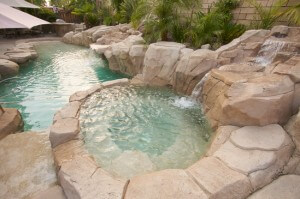To get the most out of energy efficient pool pumps it is important to understand the critical parameters that govern the pool. As a general rule, one complete turnover of water every 24 hours provides adequate filtering for a single-family pool. The more you use your pool, the more filtering it will need. It is generally recommended that you run your filter for four to six hours a day during the summer and two to four hours a day during the winter.
If you’re filtering more than this, try reducing your daily filtering time by 30 minutes. After a week, if the water clarity and chemical balance show adequate filtration is taking place, try reducing your filtering time by another 30 minutes. Continue this process until water clarity or chemical imbalance indicates more filtering is needed.
- In addition to chemical testing, a good way to check your water clarity is that the main drain cover should be clearly visible from the deck.
- Automatic pool sweeps (booster pump style): Usually, three to four hours of daily operation during summer and two to three hours daily in the winter are sufficient. Start the pool sweep one hour or more after the pool pump has started and stop the sweep one hour or more before the pool pump turns off. On unusually dusty days, increase cleaning time in half-hour increments until the pool is clean. Use a wall brush and leaf skimmer frequently to help the sweep along.
- Filter during off-peak times: You can help everyone by filtering your pool during off-peak hours. Avoid operating your pool filter between the hours of noon and 6 p.m. This will help reduce the demand for electricity, conserve natural resources, and save money. However, if your pool has solar heating, you’ll need to filter when the sun is correctly positioned for your solar panels. However, we recommend that you minimize filtration during the peak period of noon to 6 p.m. as much as possible.
- Setting filtering time: A filter time clock is an easy way to manage pool filtering. Just be sure to check it once a month to make sure the trippers are secure. Check your clock’s instruction manual for directions on setting the operation times. Remember to reset the time clock after power outages and for the fall and spring time change.
- Preventive maintenance: Follow a regular program of preventive maintenance, including an annual inspection and de-liming of the heat exchanger to help maintain heating efficiency.
- Motor and pump assembly: When its time to replace your old motor and pump assembly, consider a new energy-efficient model with a closed impeller and reduced horsepower. It moves more water more efficiently, and may help you reduce your filter operating time by an hour or more. Also consider purchasing a two speed motor with an automatic controller. The high speed is used only when needed for tasks like pool vacuuming, operating the automatic pool sweep and pump operation for the pool/spa combination. Once the heavy work is done, the controller automatically kicks down to low speed for your pool’s daily filtration cycle, which may result in energy and money savings for you.
- Energy Consumption: The size and operation time of the pump motor determines operating costs. Example: A pool owner has a 1.5 hp filter pump motor and filters the pool for 12 hours per day, using 552 kWh per month. By reducing the filtering time to 4 hours per day, the pool owner uses only 184 kWh each month, saving 368 kWh monthly, which translates to an estimated net savings of $55 each month.*
* Approximate operating costs are based on 15¢ per kWh. The price you pay may vary depending on market prices, your tiered rate and other factors.
- Water temperature: The American Red Cross recommends that the most healthful swimming pool temperature is 78°F–82°F. Be sure to use an accurate pool thermometer, since a variance of just four degrees above 78°F could use as much as 40% more energy. Shelter the pool where possible from prevailing winds by using well trimmed hedges or other landscaping, cabanas or fencing as windbreaks.
- Solar heating: Swimming pool heating is a popular application of solar energy. If your pool is in direct sunlight, the sun helps to raise and maintain the water temperature free of charge. Special solar heating pool systems can be installed in your pool to heat water pumped through solar panels. In many cases, you can add a solar system to your existing filter pump and plumbing. Buying and installing a solar-heating system can be a significant investment, so be sure to shop around and get the best combination of price, performance and warranty
